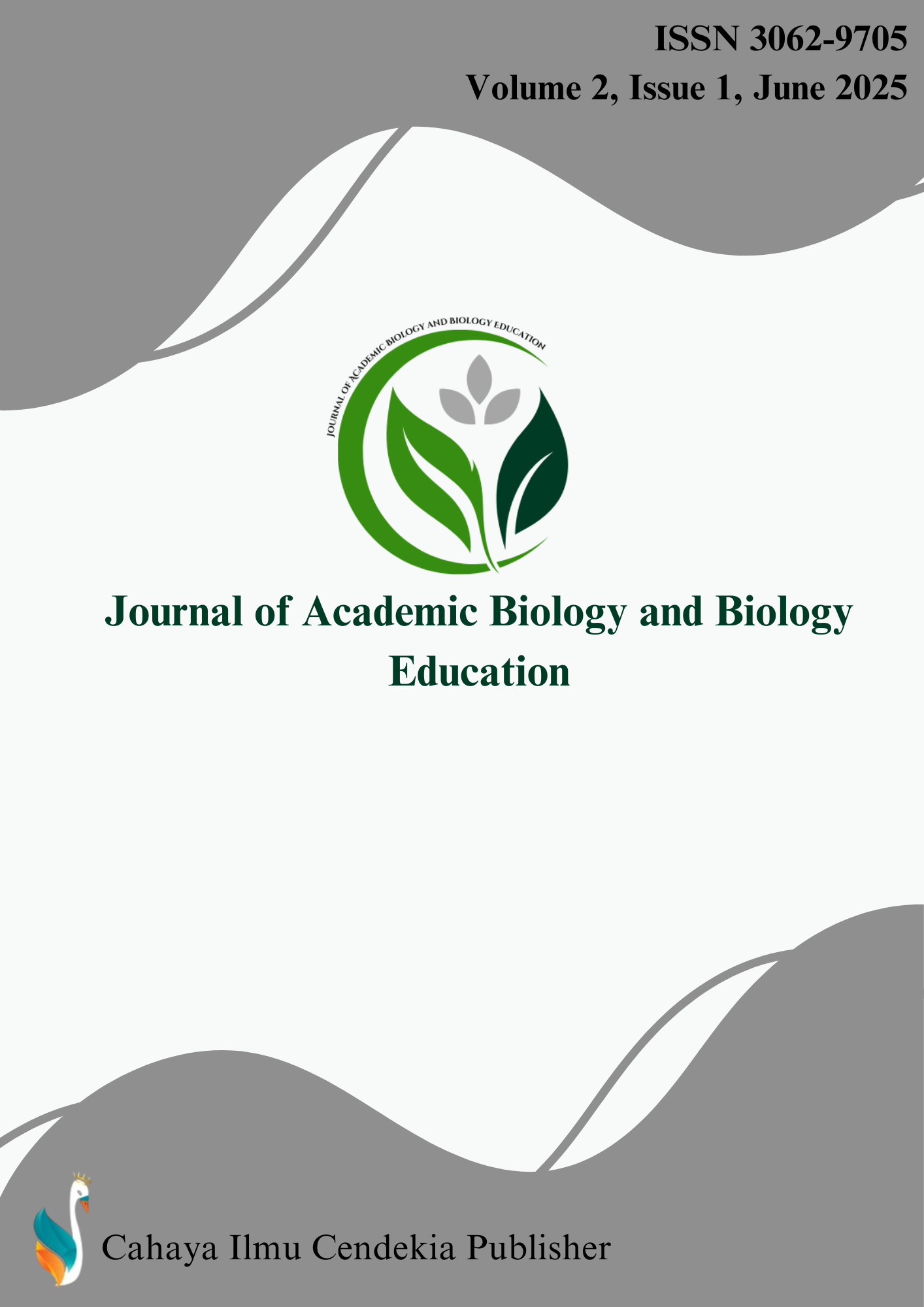Dual Gene Regulation by Hypoxia-Conditioned MSC Exosomes in a UV-B–Induced Collagen Loss Model: Targeting p21 and Cyclin D for Skin Regeneration
Abstract
Purpose of the study: This study aims to investigate the effect of hypoxia-conditioned MSC-derived exosomes (E-MSCs) on the expression of p21 and Cyclin D genes in a UV-B-induced collagen loss mouse model, using in vivo experiments and gene expression analysis.
Methodology: This in vivo experimental study used a Post-Test Only Control Group Design with male Wistar rats (Rattus norvegicus), UV-B lamp TLF72-100W/12 (Philips, 302 nm), RT-PCR machine (Bio-Rad CFX96), flow cytometer (BD FACSCalibur), centrifuge (Eppendorf 5804R), TFF filter (Repligen KrosFlo), Masson’s Trichrome staining, and SPSS 26.0 for data analysis.
Main Findings: E-MSCs at 200 µL and 300 µL significantly increased p21 and Cyclin D gene expression in UV-B–induced collagen loss model in male Wistar rats. Highest expression was found in the 300 µL E-MSCs group. ANOVA and Kruskal–Wallis tests showed significant differences (p < 0.05) between treatment and control groups, confirming the therapeutic potential of E-MSCs in regulating gene expression related to skin regeneration.
Novelty/Originality of this study: This study is the first to investigate the in vivo effects of hypoxia-conditioned MSC-derived exosomes (E-MSCs) on both p21 and Cyclin D gene expression in a UV-B–induced collagen loss model. It advances existing knowledge by revealing the dual regulatory role of E-MSCs in cell cycle arrest and proliferation, contributing to innovative skin regeneration therapies.
References
M. Wei, X. He, N. Liu, and H. Deng, “Role of reactive oxygen species in ultraviolet-induced photodamage of the skin,” Cell Div., vol. 19, no. 1, pp. 1–9, 2024, doi: 10.1186/s13008-024-00107-z.
A. Sajeeda et al., “Seabuckthorn pulp extract alleviates UV-B-induced skin photo-damage by significantly reducing oxidative stress-mediated endoplasmic reticulum stress and DNA Damage in human primary skin fibroblasts and Balb/c mice skin,” Environ. Sci. Pollut. Res., vol. 31, no. 34, pp. 46979–46993, 2024, doi: 10.1007/s11356-024-34219-4.
H. Park et al., “Extracellular matrix‐bioinspired anisotropic topographical cues of electrospun nanofibers: a strategy of wound healing through macrophage polarization,” Adv. Healthc. Mater., vol. 13, no. 12, May 2024, doi: 10.1002/adhm.202304114.
A. Berdiaki, M. Neagu, P. Tzanakakis, I. Spyridaki, S. Pérez, and D. Nikitovic, “Extracellular matrix components and mechanosensing pathways in health and disease,” Biomolecules, vol. 14, no. 9, p. 1186, Sep. 2024, doi: 10.3390/biom14091186.
E. Csekes and L. Račková, “Skin aging, cellular senescence and natural polyphenols,” Int. J. Mol. Sci., vol. 22, no. 23, p. 12641, Nov. 2021, doi: 10.3390/ijms222312641.
J. Flieger, M. Raszewska-Famielec, E. Radzikowska-Büchner, and W. Flieger, “Skin protection by carotenoid pigments,” Int. J. Mol. Sci., vol. 25, no. 3, p. 1431, Jan. 2024, doi: 10.3390/ijms25031431.
E. Manousakis, C. M. Miralles, M. G. Esquerda, and R. H. G. Wright, “CDKN1A/p21 in breast cancer: part of the problem, or part of the solution?,” Int. J. Mol. Sci., vol. 24, no. 24, p. 17488, Dec. 2023, doi: 10.3390/ijms242417488.
K. Engeland, “Cell cycle regulation: p53-p21-RB signaling,” Cell Death Differ., vol. 29, no. 5, pp. 946–960, 2022, doi: 10.1038/s41418-022-00988-z.
M. Fischer, A. E. Schade, T. B. Branigan, G. A. Müller, and J. A. DeCaprio, “Coordinating gene expression during the cell cycle,” Trends Biochem. Sci., vol. 47, no. 12, pp. 1009–1022, 2022, doi: 10.1016/j.tibs.2022.06.007.
L. Zhu, J. Liu, J. Chen, and Q. Zhou, “The developing landscape of combinatorial therapies of immune checkpoint blockade with DNA damage repair inhibitors for the treatment of breast and ovarian cancers,” J. Hematol. Oncol., vol. 14, no. 1, pp. 1–19, 2021, doi: 10.1186/s13045-021-01218-8.
C. Q. X. Yam, H. H. Lim, and U. Surana, “DNA damage checkpoint execution and the rules of its disengagement,” Front. Cell Dev. Biol., vol. 10, no. October, pp. 1–15, 2022, doi: 10.3389/fcell.2022.1020643.
Z. Zhang, R. Tan, Z. Xiong, Y. Feng, and L. Chen, “Dysregulation of autophagy during photoaging reduce oxidative stress and inflammatory damage caused by UV,” Front. Pharmacol., vol. 16, no. May, pp. 1–27, 2025, doi: 10.3389/fphar.2025.1562845.
M. Zhang et al., “Exploring mechanisms of skin aging: insights for clinical treatment,” Front. Immunol., vol. 15, no. November, pp. 1–23, 2024, doi: 10.3389/fimmu.2024.1421858.
G. J. Fisher et al., “Skin aging from the perspective of dermal fibroblasts: the interplay between the adaptation to the extracellular matrix microenvironment and cell autonomous processes,” J. Cell Commun. Signal., vol. 17, no. 3, pp. 523–529, Sep. 2023, doi: 10.1007/s12079-023-00743-0.
N. N. Potekaev et al., “The role of extracellular matrix in skin wound healing,” J. Clin. Med., vol. 10, no. 24, p. 5947, Dec. 2021, doi: 10.3390/jcm10245947.
M. Y. Waqas et al., “Extracellular vesicles and exosome: insight from physiological regulatory perspectives,” J. Physiol. Biochem., vol. 78, no. 3, pp. 573–580, 2022, doi: 10.1007/s13105-022-00877-6.
M. A. Kumar et al., “Extracellular vesicles as tools and targets in therapy for diseases,” Signal Transduct. Target. Ther., vol. 9, no. 1, 2024, doi: 10.1038/s41392-024-01735-1.
D. Bian, Y. Wu, G. Song, R. Azizi, and A. Zamani, “The application of mesenchymal stromal cells (MSCs) and their derivative exosome in skin wound healing: a comprehensive review,” Stem Cell Res. Ther., vol. 13, no. 1, pp. 1–17, 2022, doi: 10.1186/s13287-021-02697-9.
C. Zhou et al., “Stem cell-derived exosomes: emerging therapeutic opportunities for wound healing,” Stem Cell Res. Ther., vol. 14, no. 1, pp. 1–18, 2023, doi: 10.1186/s13287-023-03345-0.
S. Rautiainen, T. Laaksonen, and R. Koivuniemi, “Angiogenic effects and crosstalk of adipose-derived mesenchymal stem/stromal cells and their extracellular vesicles with endothelial cells,” Int. J. Mol. Sci., vol. 22, no. 19, p. 10890, Oct. 2021, doi: 10.3390/ijms221910890.
Z. Ji et al., “Oct4-dependent FoxC1 activation improves the survival and neovascularization of mesenchymal stem cells under myocardial ischemia,” Stem Cell Res. Ther., vol. 12, no. 1, pp. 1–23, 2021, doi: 10.1186/s13287-021-02553-w.
Y. Zhang et al., “Exosomes derived from human umbilical cord blood mesenchymal stem cells stimulate regenerative wound healing via transforming growth factor-β receptor inhibition,” Stem Cell Res. Ther., vol. 12, no. 1, pp. 1–14, 2021, doi: 10.1186/s13287-021-02517-0.
S. Hu et al., “Needle-free injection of exosomes derived from human dermal fibroblast spheroids ameliorates skin photoaging.,” Physiol. Behav., vol. 176, no. 3, pp. 139–148, 2019, doi: 10.1021/acsnano.9b04384.Extra.
Y. You et al., “Intradermally delivered mRNA-encapsulating extracellular vesicles for collagen-replacement therapy,” Nat. Biomed. Eng., vol. 7, no. 7, pp. 887–900, 2023, doi: 10.1038/s41551-022-00989-w.
J. Li, Z. Li, S. Wang, J. Bi, and R. Huo, “Exosomes from human adipose-derived mesenchymal stem cells inhibit production of extracellular matrix in keloid fibroblasts via downregulating transforming growth factor-β2 and Notch-1 expression,” Bioengineered, vol. 13, no. 4, pp. 8515–8525, 2022, doi: 10.1080/21655979.2022.2051838.
R. Tutuianu, A.-M. Rosca, D. M. Iacomi, M. Simionescu, and I. Titorencu, “Human mesenchymal stromal cell-derived exosomes promote in vitro wound healing by modulating the biological properties of skin keratinocytes and fibroblasts and stimulating angiogenesis,” Int. J. Mol. Sci., vol. 22, no. 12, p. 6239, Jun. 2021, doi: 10.3390/ijms22126239.
N. Kwon, K. E. Lee, M. Singh, and S. G. Kang, “Suitable primers for GAPDH reference gene amplification in quantitative RT-PCR analysis of human gene expression,” Gene Reports, vol. 24, p. 101272, 2021, doi: https://doi.org/10.1016/j.genrep.2021.101272.
A. Caballero-Solares, J. R. Hall, X. Xue, and M. L. Rise, “Reverse Transcription-Quantitative Real-Time Polymerase Chain Reaction (RT-qPCR) for Gene Expression Analyses BT - Cancer Cell Biology: Methods and Protocols,” S. L. Christian, Ed., New York, NY: Springer US, 2022, pp. 319–340. doi: 10.1007/978-1-0716-2376-3_21.
M. Fiandini, A. B. D. Nandiyanto, D. F. Al Husaeni, D. N. Al Husaeni, and M. Mushiban, “How to calculate statistics for significant difference test using SPSS: understanding students comprehension on the concept of steam engines as power plant,” Indones. J. Sci. Technol., vol. 9, no. 1, pp. 45–108, 2024, doi: 10.17509/ijost.v9i1.64035.
B. K. Blajvaz, I. Z. Bogdanović, T. S. Jovanović, J. D. Stanisavljević, and M. V. Pavkov-Hrvojević, “The jigsaw technique in lower secondary physics education: students’ achievement, metacognition and motivation,” J. Balt. Sci. Educ., vol. 21, no. 4, pp. 545–557, 2022, doi: 10.33225/jbse/22.21.545.
P. T. Pugliese, Physiology of the Skin II: An Expanded Scientific Guide for the Skin Care Professional. Allured Publishing Corporation, 2001. [Online]. Available: https://books.google.co.id/books?id=WOSYPQAACAAJ
C. Harrell, C. Fellabaum, N. Jovicic, V. Djonov, N. Arsenijevic, and V. Volarevic, “Molecular mechanisms responsible for therapeutic potential of mesenchymal stem cell-derived secretome,” Cells, vol. 8, no. 5, p. 467, May 2019, doi: 10.3390/cells8050467.
D. Kyurkchiev, “Secretion of immunoregulatory cytokines by mesenchymal stem cells,” World J. Stem Cells, vol. 6, no. 5, p. 552, 2014, doi: 10.4252/wjsc.v6.i5.552.
L. Wang et al., “Transforming growth factor β plays an important role in enhancing wound healing by topical application of Povidone-iodine,” Sci. Rep., vol. 7, no. 1, pp. 1–8, 2017, doi: 10.1038/s41598-017-01116-5.
P.-S. Lin et al., “Transforming growth factor beta 1 increases collagen content, and stimulates procollagen I and tissue inhibitor of metalloproteinase-1 production of dental pulp cells: Role of MEK/ERK and activin receptor-like kinase-5/Smad signaling,” J. Formos. Med. Assoc., vol. 116, no. 5, pp. 351–358, May 2017, doi: 10.1016/j.jfma.2016.07.014.
D.-S. Kim, S.-H. Park, and K.-C. Park, “Transforming growth factor-β1 decreases melanin synthesis via delayed extracellular signal-regulated kinase activation,” Int. J. Biochem. Cell Biol., vol. 36, no. 8, pp. 1482–1491, Aug. 2004, doi: 10.1016/j.biocel.2003.10.023.
H. Yang, G. Li, J.-J. Wu, L. Wang, M. Uhler, and D. M. Simeone, “Protein kinase a modulates transforming growth factor-β signaling through a direct interaction with Smad4 protein,” J. Biol. Chem., vol. 288, no. 12, pp. 8737–8749, Mar. 2013, doi: 10.1074/jbc.M113.455675.
P. S. Siebenga, G. van Amerongen, E. S. Klaassen, M. L. de Kam, R. Rissmann, and G. J. Groeneveld, “The ultraviolet B inflammation model: Postinflammatory hyperpigmentation and validation of a reduced UVB exposure paradigm for inducing hyperalgesia in healthy subjects,” Eur. J. Pain (United Kingdom), vol. 23, no. 5, pp. 874–883, 2019, doi: 10.1002/ejp.1353.
Y. Gao, D. Tu, R. Yang, C. H. Chu, H. M. Gao, and J. S. Hong, “Through reducing ROS production, IL-10 suppresses caspase-1-dependent IL-1β maturation, thereby preventing chronic neuroinflammation and neurodegeneration,” Int. J. Mol. Sci., vol. 21, no. 2, pp. 1–15, 2020, doi: 10.3390/ijms21020465.
D. G. Phinney and M. F. Pittenger, “Concise review: MSC-derived exosomes for cell-free therapy,” Stem Cells, vol. 35, no. 4, pp. 851–858, Apr. 2017, doi: 10.1002/stem.2575.
J. Li, J. Wang, and Z. Chen, “Emerging role of exosomes in cancer therapy: progress and challenges.,” Mol. Cancer, vol. 24, no. 1, p. 13, Jan. 2025, doi: 10.1186/s12943-024-02215-4.
Copyright (c) 2025 Riaflor Alcabedos, Ooi Siew Fong

This work is licensed under a Creative Commons Attribution 4.0 International License.
Authors who publish with this journal agree to the following terms:
- Authors retain copyright and acknowledge that the Journal of Academic Biology and Biology Education is the first publisher licensed under a Creative Commons Attribution 4.0 International License.
- Authors are able to enter into separate, additional contractual arrangements for the non-exclusive distribution of the journal's published version of the work (e.g., post it to an institutional repository or publish it in a book), with an acknowledgment of its initial publication in this journal.
- Authors are permitted and encouraged to post their work online (e.g., in institutional repositories or on their website) prior to and during the submission process, as it can lead to productive exchanges and earlier and greater citation of published work.



.png)

.png)
.png)








